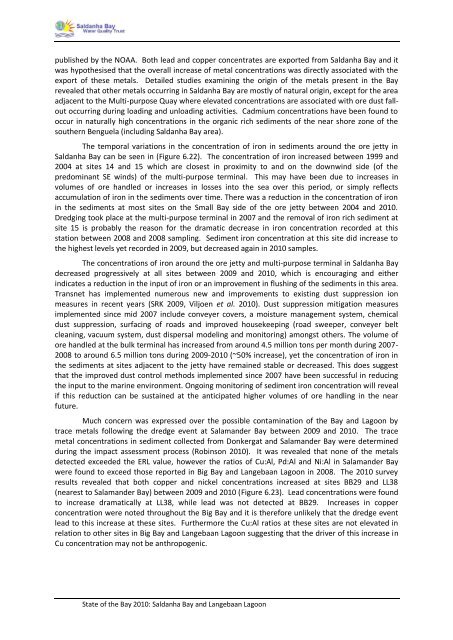State of the Bay Report 2010-Final - Anchor Environmental
State of the Bay Report 2010-Final - Anchor Environmental
State of the Bay Report 2010-Final - Anchor Environmental
You also want an ePaper? Increase the reach of your titles
YUMPU automatically turns print PDFs into web optimized ePapers that Google loves.
published by <strong>the</strong> NOAA. Both lead and copper concentrates are exported from Saldanha <strong>Bay</strong> and it<br />
was hypo<strong>the</strong>sised that <strong>the</strong> overall increase <strong>of</strong> metal concentrations was directly associated with <strong>the</strong><br />
export <strong>of</strong> <strong>the</strong>se metals. Detailed studies examining <strong>the</strong> origin <strong>of</strong> <strong>the</strong> metals present in <strong>the</strong> <strong>Bay</strong><br />
revealed that o<strong>the</strong>r metals occurring in Saldanha <strong>Bay</strong> are mostly <strong>of</strong> natural origin, except for <strong>the</strong> area<br />
adjacent to <strong>the</strong> Multi-purpose Quay where elevated concentrations are associated with ore dust fallout<br />
occurring during loading and unloading activities. Cadmium concentrations have been found to<br />
occur in naturally high concentrations in <strong>the</strong> organic rich sediments <strong>of</strong> <strong>the</strong> near shore zone <strong>of</strong> <strong>the</strong><br />
sou<strong>the</strong>rn Benguela (including Saldanha <strong>Bay</strong> area).<br />
The temporal variations in <strong>the</strong> concentration <strong>of</strong> iron in sediments around <strong>the</strong> ore jetty in<br />
Saldanha <strong>Bay</strong> can be seen in (Figure 6.22). The concentration <strong>of</strong> iron increased between 1999 and<br />
2004 at sites 14 and 15 which are closest in proximity to and on <strong>the</strong> downwind side (<strong>of</strong> <strong>the</strong><br />
predominant SE winds) <strong>of</strong> <strong>the</strong> multi-purpose terminal. This may have been due to increases in<br />
volumes <strong>of</strong> ore handled or increases in losses into <strong>the</strong> sea over this period, or simply reflects<br />
accumulation <strong>of</strong> iron in <strong>the</strong> sediments over time. There was a reduction in <strong>the</strong> concentration <strong>of</strong> iron<br />
in <strong>the</strong> sediments at most sites on <strong>the</strong> Small <strong>Bay</strong> side <strong>of</strong> <strong>the</strong> ore jetty between 2004 and <strong>2010</strong>.<br />
Dredging took place at <strong>the</strong> multi-purpose terminal in 2007 and <strong>the</strong> removal <strong>of</strong> iron rich sediment at<br />
site 15 is probably <strong>the</strong> reason for <strong>the</strong> dramatic decrease in iron concentration recorded at this<br />
station between 2008 and 2008 sampling. Sediment iron concentration at this site did increase to<br />
<strong>the</strong> highest levels yet recorded in 2009, but decreased again in <strong>2010</strong> samples.<br />
The concentrations <strong>of</strong> iron around <strong>the</strong> ore jetty and multi-purpose terminal in Saldanha <strong>Bay</strong><br />
decreased progressively at all sites between 2009 and <strong>2010</strong>, which is encouraging and ei<strong>the</strong>r<br />
indicates a reduction in <strong>the</strong> input <strong>of</strong> iron or an improvement in flushing <strong>of</strong> <strong>the</strong> sediments in this area.<br />
Transnet has implemented numerous new and improvements to existing dust suppression ion<br />
measures in recent years (SRK 2009, Viljoen et al. <strong>2010</strong>). Dust suppression mitigation measures<br />
implemented since mid 2007 include conveyer covers, a moisture management system, chemical<br />
dust suppression, surfacing <strong>of</strong> roads and improved housekeeping (road sweeper, conveyer belt<br />
cleaning, vacuum system, dust dispersal modeling and monitoring) amongst o<strong>the</strong>rs. The volume <strong>of</strong><br />
ore handled at <strong>the</strong> bulk terminal has increased from around 4.5 million tons per month during 2007-<br />
2008 to around 6.5 million tons during 2009-<strong>2010</strong> (~50% increase), yet <strong>the</strong> concentration <strong>of</strong> iron in<br />
<strong>the</strong> sediments at sites adjacent to <strong>the</strong> jetty have remained stable or decreased. This does suggest<br />
that <strong>the</strong> improved dust control methods implemented since 2007 have been successful in reducing<br />
<strong>the</strong> input to <strong>the</strong> marine environment. Ongoing monitoring <strong>of</strong> sediment iron concentration will reveal<br />
if this reduction can be sustained at <strong>the</strong> anticipated higher volumes <strong>of</strong> ore handling in <strong>the</strong> near<br />
future.<br />
Much concern was expressed over <strong>the</strong> possible contamination <strong>of</strong> <strong>the</strong> <strong>Bay</strong> and Lagoon by<br />
trace metals following <strong>the</strong> dredge event at Salamander <strong>Bay</strong> between 2009 and <strong>2010</strong>. The trace<br />
metal concentrations in sediment collected from Donkergat and Salamander <strong>Bay</strong> were determined<br />
during <strong>the</strong> impact assessment process (Robinson <strong>2010</strong>). It was revealed that none <strong>of</strong> <strong>the</strong> metals<br />
detected exceeded <strong>the</strong> ERL value, however <strong>the</strong> ratios <strong>of</strong> Cu:Al, Pd:Al and Ni:Al in Salamander <strong>Bay</strong><br />
were found to exceed those reported in Big <strong>Bay</strong> and Langebaan Lagoon in 2008. The <strong>2010</strong> survey<br />
results revealed that both copper and nickel concentrations increased at sites BB29 and LL38<br />
(nearest to Salamander <strong>Bay</strong>) between 2009 and <strong>2010</strong> (Figure 6.23). Lead concentrations were found<br />
to increase dramatically at LL38, while lead was not detected at BB29. Increases in copper<br />
concentration were noted throughout <strong>the</strong> Big <strong>Bay</strong> and it is <strong>the</strong>refore unlikely that <strong>the</strong> dredge event<br />
lead to this increase at <strong>the</strong>se sites. Fur<strong>the</strong>rmore <strong>the</strong> Cu:Al ratios at <strong>the</strong>se sites are not elevated in<br />
relation to o<strong>the</strong>r sites in Big <strong>Bay</strong> and Langebaan Lagoon suggesting that <strong>the</strong> driver <strong>of</strong> this increase in<br />
Cu concentration may not be anthropogenic.<br />
<strong>State</strong> <strong>of</strong> <strong>the</strong> <strong>Bay</strong> <strong>2010</strong>: Saldanha <strong>Bay</strong> and Langebaan Lagoon

















